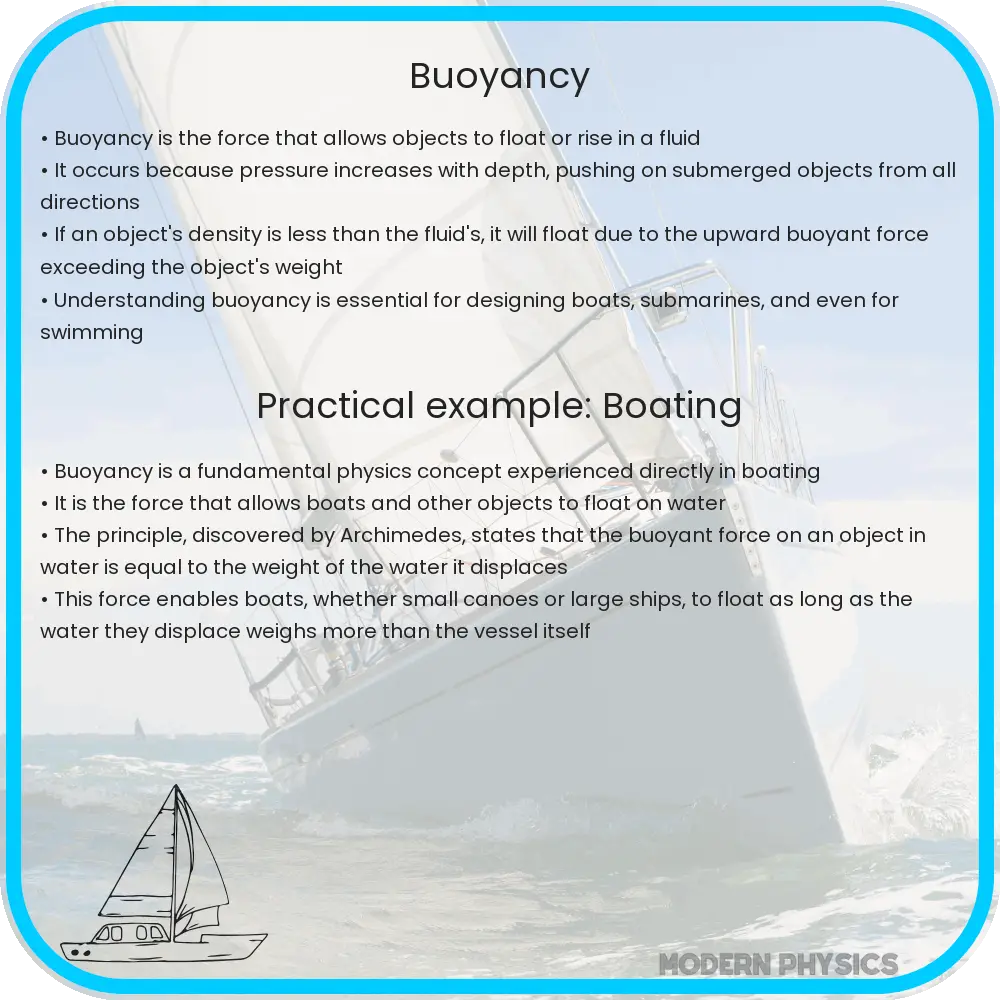Explore the principles of buoyancy in fluid dynamics, its applications in engineering, environmental science, and recreational activities.

Understanding Buoyancy: Key Concepts in Fluid Dynamics
Buoyancy, a fundamental principle in fluid dynamics, plays a crucial role in understanding how objects behave in fluids like water or air. It explains why some objects float, others sink, and how submarines and hot air balloons operate. This concept is not just vital for marine and aeronautical engineering but also for understanding natural phenomena.
The Principle of Buoyancy
At its core, buoyancy is the upward force exerted by a fluid that opposes the weight of an immersed object. According to Archimedes’ principle, the buoyant force on an object submerged in a fluid is equal to the weight of the fluid displaced by the object. This principle can be mathematically expressed as:
- Fb = ρf × Vdisplaced × g, where:
- Fb is the buoyant force,
- ρf is the density of the fluid,
- Vdisplaced is the volume of the displaced fluid, and
- g is the acceleration due to gravity.
This formula highlights how the buoyant force depends on the density of the fluid and the volume of fluid displaced.
Determining Whether an Object Will Float or Sink
An object’s ability to float or sink in a fluid primarily depends on its density relative to the fluid’s density. If an object’s density is less than the fluid’s density, it will float. Conversely, if it’s more, the object will sink. The concept of specific gravity, which is the ratio of the density of an object to the density of a reference substance (usually water), further helps in understanding this phenomenon.
Fluid Forces and Motion
Beyond buoyancy, other forces act on bodies in fluids, such as drag and lift. Drag is the resistance force caused by the motion of a body through a fluid, while lift is the force perpendicular to the direction of motion. Both of these are crucial in designing vehicles like airplanes and boats, where balance between these forces is key to stable and efficient motion.
Understanding these dynamics is essential for many fields, from naval architecture to environmental science, where the interaction of objects with fluids is a critical aspect.
In the next section, we will delve deeper into the applications of buoyancy in various fields, illustrating its importance in practical and theoretical contexts.
Applications of Buoyancy in Various Fields
Buoyancy finds its applications in a wide array of fields, demonstrating its versatility and importance. In marine engineering, buoyancy is fundamental for designing ships and submarines, ensuring they float and can be maneuvered underwater. For ships, the balance between the weight of the vessel and the buoyant force is crucial for stability. Submarines manipulate buoyancy for submerging and surfacing by adjusting the weight of water in their ballast tanks.
In aeronautics, buoyancy principles are applied in designing airships and hot air balloons. These aircraft use the principle of hot air being less dense than cold air to create lift. By heating the air inside the balloon, it becomes less dense than the surrounding air, causing the balloon to rise.
Buoyancy in Environmental Science
Buoyancy also plays a significant role in environmental science, particularly in understanding aquatic ecosystems. The buoyancy of water bodies affects water circulation, which in turn influences climate patterns and marine life distribution. In studying pollution, understanding how different pollutants with varying densities behave in water bodies is crucial for environmental protection and cleanup efforts.
Fluid Dynamics in Sports and Recreation
In sports and recreation, buoyancy principles are essential in activities like swimming, diving, and boating. Understanding how the human body interacts with water, and how to manipulate this interaction, is key to performance and safety in these activities.
Conclusion
The principle of buoyancy, integral to fluid dynamics, is a fundamental concept that extends far beyond the realm of physics and engineering. Its applications range from designing ships and aircraft to understanding environmental phenomena and enhancing sports techniques. The ability to calculate and manipulate buoyant forces allows for the advancement of technology, the preservation of the environment, and the enhancement of recreational activities. By grasping the principles of buoyancy and fluid forces, we gain deeper insights into the natural world and our interaction with it, illustrating the profound impact of this fundamental scientific principle on our daily lives.
